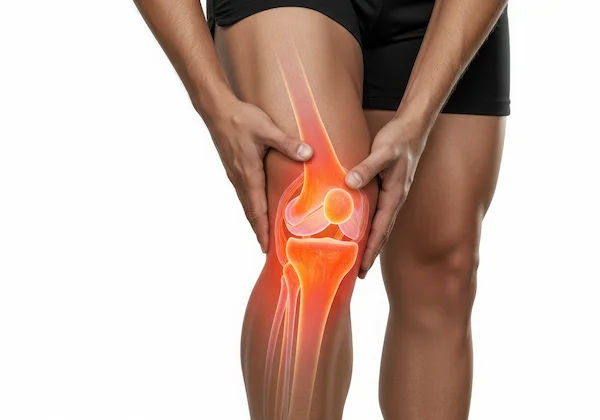Quick Home Remedies for Sprained Ankle
Discover quick and effective home remedies for a sprained ankle, including the R.I.C.E method, pain relief, exercises, and natural treatments to promote faster healing.

Written by
Last updated on 3rd Jul, 2025
Introduction
A sprained ankle is a common injury that occurs when the ligaments that support the ankle stretch or tear. This can happen during physical activities, sports, or even from a simple misstep. While a sprained ankle can be painful and inconvenient, there are several effective home remedies that can help alleviate pain, reduce swelling, and promote healing. In this article, we will explore various quick home remedies for a sprained ankle, providing you with actionable advice to manage this injury effectively.
Understanding a Sprained Ankle
Before exploring about the remedies, it's essential to understand what a sprained ankle is and how it occurs. A sprain happens when the ligaments, which are tough bands of tissue that connect bones, are stretched beyond their normal range of motion. This can result in partial or complete tears of the ligaments. The severity of a sprain can vary, ranging from mild (Grade 1) to severe (Grade 3).
Common symptoms of a sprained ankle
Recognising the symptoms of a sprained ankle is crucial for proper diagnosis and treatment. Here are the common symptoms associated with a sprained ankle:
Pain
Immediate Pain: Pain is usually felt immediately after the injury occurs. The intensity of the pain can vary depending on the severity of the sprain.
Localised Pain: The pain is typically localised around the ankle joint, especially on the outer side of the ankle.
Pain with Movement: Moving the ankle or putting weight on it can exacerbate the pain.
Swelling
Rapid Onset: Swelling often occurs quickly after the injury. It is caused by the accumulation of fluid around the injured area.
Visible Swelling: The ankle may appear visibly swollen, and the swelling can extend to the foot and lower leg.
Bruising
Discolouration: Bruising may develop around the ankle, foot, and lower leg. The bruising can range from mild to severe and may change colour over time.
Delayed Bruising: Bruising may not be immediately visible and can appear a few hours or days after the injury.
Limited Range of Motion
Stiffness: The ankle may feel stiff and difficult to move.
Reduced Mobility: The range of motion in the ankle joint may be limited, making it challenging to perform everyday activities.
Tenderness
Sensitive to Touch: The injured area may be tender to the touch, and pressing on the affected ligaments can cause discomfort.
Localised Tenderness: Tenderness is usually felt around the outer side of the ankle, where the ligaments are most commonly injured.
Instability
The Feeling of Giving Way: The ankle may feel unstable or as if it is "giving way" when walking or standing.
Weakness: There may be a sensation of weakness in the ankle, making it difficult to bear weight.
Difficulty Bearing Weight
Inability to Walk: In severe cases, it may be difficult or impossible to walk or put weight on the injured ankle.
Limping: Individuals with a sprained ankle may limp or avoid putting pressure on the affected foot.
Warmth and Redness
Inflammation: The injured area may feel warm to the touch and appear red due to inflammation.
Quick Home Remedies for Sprained Ankle
Here are some effective home remedies to help you manage a sprained ankle:
R.I.C.E Method: The R.I.C.E method is a fundamental approach to treating a sprained ankle. It stands for Rest, Ice, Compression, and Elevation. Here's how to apply it:
Rest: Avoid putting weight on the injured ankle. Use crutches if necessary to prevent further damage and facilitate healing.
Ice: Apply ice packs for 15-20 minutes every 2-3 hours during the first 48 hours. Ice reduces pain and swelling by constricting blood vessels and numbing the area.
Compression: Wrap the ankle with an elastic bandage to control swelling and provide support. Make sure the wrap is snug but not too tight to avoid restricted blood flow.
Elevation: Keep the injured ankle elevated above heart level to reduce swelling and promote drainage.
Pain Medications: Over-the-counter pain medications, such as ibuprofen or acetaminophen, can help reduce pain and inflammation. Always follow the recommended dosage and consult a healthcare professional if needed.
Massage: Gently massaging the injured ankle can help improve blood circulation and reduce muscle tension. Use your fingers to apply gentle pressure in circular motions around the affected area.
Heat Therapy: After the initial 48 hours, applying heat to the injured ankle can help relax muscles and improve blood flow. Use a warm compress or heating pad for 15-20 minutes at a time.
Epsom Salt Soak: Soaking the injured ankle in warm water mixed with Epsom salt can help reduce swelling and relieve pain. Add about half a cup of Epsom salt to a basin of warm water and soak the ankle for 15-20 minutes.
Ankle Brace: Wearing an ankle brace can provide support and stability to the injured ankle, helping to prevent further injury and promote healing.
Gentle Exercises: Once the initial pain and swelling have subsided, gentle exercises can help restore mobility and strength to the ankle. Start with simple range-of-motion exercises, such as ankle circles and toe flexion/extension.
Proper Footwear: Wearing supportive and comfortable footwear can help prevent further injury and provide stability to the injured ankle. Avoid high heels and opt for shoes with good arch support.
Diet and Hydration: Maintaining a healthy diet and staying hydrated can support the healing process. Foods rich in vitamins and minerals, such as fruits, vegetables, and lean proteins, can promote tissue repair and reduce inflammation.
Essential Oils: Certain essential oils, such as lavender, peppermint, and eucalyptus, have anti-inflammatory and pain-relieving properties. Dilute a few drops of essential oil in a carrier oil and gently massage it into the affected area.
Turmeric Paste: Turmeric is known for its anti-inflammatory properties. Create a paste by mixing turmeric powder with water or coconut oil and apply it to the sprained ankle. Leave it on for 20-30 minutes before rinsing off.
Ginger Tea: Ginger has natural anti-inflammatory properties that can help reduce swelling and pain. Brew a cup of ginger tea by boiling fresh ginger slices in water for 10-15 minutes. Drink the tea 2-3 times a day for relief.
Arnica Gel: Arnica is a natural remedy known for its ability to reduce pain and inflammation. Apply arnica gel to the sprained ankle several times a day to help alleviate symptoms.
Compression Socks: Compression socks can help reduce swelling and provide support to the injured ankle. Wear them throughout the day to promote healing.
Rest and Recovery: Allowing your ankle to rest and recover is crucial for healing. Avoid activities that put a strain on the ankle and give it time to heal properly.
Conclusion
A sprained ankle, while often painful and disruptive, is a manageable injury with the right approach to care and recovery. Utilising the R.I.C.E. method (Rest, Ice, Compression, Elevation), along with appropriate pain relief and gentle rehabilitation exercises, can help reduce swelling, alleviate pain, and promote healing. Natural remedies like Epsom salt soaks and essential oils may also provide additional comfort and support. However, it is important to listen to your body throughout the healing process, avoid overexertion, and seek medical attention if symptoms worsen or do not improve. By following these strategies, you can aid your recovery and help ensure stronger, healthier ankles in the long term.
Consult Top Orthopaedicians
Consult Top Orthopaedicians

Dr Chetan Pophale
Spine Surgeon
10 Years • MBBS, D. Ortho, DNB Ortho, Fellowship in Minimally Invasive & Endoscopic Spine Surgery
Chennai
Apollo Speciality Hospitals OMR, Chennai

Dr. Venkataramanan Swaminathan
Orthopaedician
24 Years • MBBS, MS (Orth), D Orth
Chennai
Apollo Speciality Hospitals OMR, Chennai
(125+ Patients)
Dr. Piyush Joshi
Orthopaedician
9 Years • MBBS, MS (Orthopedic), ASSI
Kolkata
GRD POLYCLINIC, Kolkata

Dr. Sourabh Ghosh
Orthopaedician
4 Years • MBBS, MS (Orthopaedics), Fellowship in Spine Surgery
East Midnapore
VIVEKANANDA SEBA SADAN, East Midnapore

Dr. Rupam Chowdhury
Orthopaedician
10 Years • MBBS, DNB (Ortho.)
Kolkata
MCR SUPER SPECIALITY POLY CLINIC & PATHOLOGY, Kolkata


.webp)
